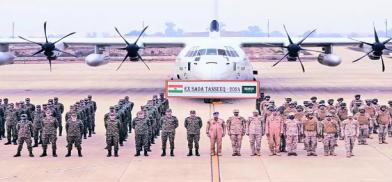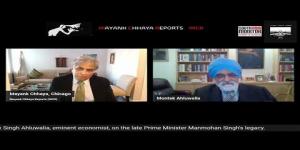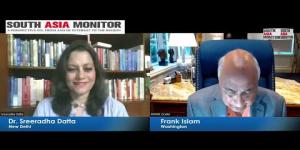Exponential growth in India-Saudi Arabia relations: Moving past the Pakistan factor
The inclusion of the military dimension in India-Saudi Arabia relations is of great strategic significance which is expected to gain more momentum in the future.

India and Saudi Arabia began diplomatic relations soon after India’s Independence in 1947, but for many decades thereafter, the Saudi government did not allow any visitor to carry even a small idol or a picture worshipped by Hindus into their country. Indian women could not wear the ‘bindi’ on their foreheads. Further, Indian women had to compulsorily wear the abaya whenever they went out. Indians were also not allowed to keep idols of Hindu deities. Hindu festivals had to be celebrated with a lot of caution, with prayers or 'bhajans'(religious songs) at low volume.
India's relations with Saudi Arabia were also affected by the latter's close ties with Pakistan. Saudi Arabia supported Pakistan's stance on the Kashmir conflict during the India-Pakistani war of 1971, at the cost of its relations with India. The erstwhile Soviet Union's close relations with India also negatively affected India-Saudi relations. During the Persian Gulf War (1990–91), India officially remained neutral. It was just not Saudi Arabia's close military and strategic ties but also its frequent financial doles to Pakistan, which India suspected were being used to fund its anti-India operations, was a factor of continuing strain.
Since the 1990s however, both nations took steps to improve ties. Saudi Arabia supported granting observer status to India in the Organisation of Islamic Cooperation (OIC) and expanded its collaboration with India to fight Islamic terrorism in the Middle East. In January 2006, King Abdullah of Saudi Arabia made a special visit to India, becoming the first Saudi monarch in 51 years to do so. The Saudi king and then Indian Prime Minister Manmohan Singh signed an agreement forging a strategic energy partnership that was termed the "Delhi Declaration. The pact provides for a "reliable, stable and increased volume of crude oil supplies to India through long-term contracts." Both nations also agreed on joint ventures and the development of oil and natural gas in public and private sectors. An India-Saudi joint declaration in New Delhi described the king's visit as "heralding a new era in India-Saudi Arabia relations.
Catalyst of change
Prince Mohammed bin Salman Al Saud, the seventh son of King Salman and grandson of the nation's founder, King Abdulaziz, is the one who turned out to be the catalyst of the turnout in bilateral ties. Since his appointment as crown prince in 2017, he introduced a series of social and economic reforms. These included curtailing the influence of the Wahhabi religious establishment by restricting the powers of the religious police and improving women's rights, the removal of the ban on female drivers in 2018 and weakening the male-guardianship system in 2019. His Saudi Vision 2030 program aims to reduce the Saudi economy's reliance on oil through investment in non-oil sectors including technology and tourism, which has contributed to greater diversification of the economy. Under Mohammed, Saudi Arabia began co-ordinating its energy policy with Russia and also strengthened its relations with China.
In 2019, Saudi Arabia increased the Haj quota from India, making it the second largest sender country in the number of pilgrims. Thus, the number of Indian pilgrims jumped to 200,000 per year in 2019.
Prime Minister Narendra Modi’s visit to Riyadh in April 2016 marked a significant boost to cooperation in the political, economic, security and defence fields. During that visit, King Salman conferred the Kingdom’s highest civilian honour, the King Abdulaziz Sash, on Prime Minister Modi, indicating the importance Saudi Arabia attached to its relations with India. The visit of Crown Prince Salman to India in February 2019 further took forward this momentum. During that visit, it was announced that the Kingdom would invest approximately US$ 100 billion in India and six MoUs/Agreements were signed in various fields, including investment, tourism, housing, exchange of audio-visual programmes, and an agreement was signed to pave way for Saudi Arabia to join the International Solar Alliance (ISA), which was launched by Prime Minister Modi.
Start of military cooperation
Former Indian Army Chief General MM Naravane’s visit to Saudi Arabia in December 2020 was an important one during which New Delhi and Riyadh agreed to expand on military cooperation including procurements and exploring defence industrial collaboration. During Lt. Gen. Fahd Bin Abdullah Mohammed Al-Mutair’s visit to New Delhi in February 2022, he and Gen. Naravane were photographed symbolically below a mural of the Pakistan Army’s famous surrender to the Indian Army at Dhaka in December 1971 leading to the birth of Bangladesh. This was yet another clear indication of the India-Saudi relationship moving past the Pakistan factor.
General Naravane’s visit eventually got a military relationship going between India and Saudi Arabia. In August 2021, both the nation’s navies held an exercise named 'Al-Mohed Al-Hindi' in Al-Jubail, Saudi Arabia. The second edition of this exercise was held in May 2023, again in Jubail.
In January 2024, the first-ever exercise between the armies of India-Saudi Arabia named ‘Sada Tanseeq’ was held at Mahajan, Rajasthan. 'Sada', meaning forever, was the word given by Indian Army and 'Tanseeq' an Arabian word for coordination, was given by the Royal Saudi Land Forces, which sent a contingent of 45 personnel. The Indian Army fielded 45 personnel from a battalion of Mechanised Infantry.
Then came the third naval event between India and Saudi Arabia, when, on 18 July 2024, 76 trainees from King Fahd Naval Academy of the Royal Saudi Naval Forces completed their Afloat Training Course at the Indian Navy’s 1st Training Squadron.
The inclusion of the military dimension in India-Saudi Arabia relations is of great strategic significance which is expected to gain more momentum in the future.
(The author, a military affairs analyst, is a former spokesperson, Defence Ministry and Indian Army. Views are personal. He can be reached at wordsword02@gmail.com)











Post a Comment